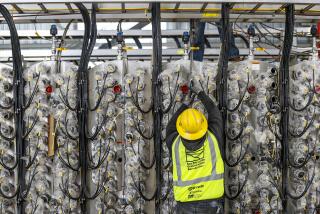TORRANCE : Desalter’s Success May Be Multiplied
Part of the South Bay’s vast underground water supply, which becomes salty from encroaching seawater, is made fit for drinking by a high-tech desalinator here.
The C. Marvin Brewer Desalting Facility is the only plant in Southern California to use reverse osmosis to produce drinking water from brackish wells. The $2-million desalter began pumping in May, 1993, and provides 1.5 million gallons of fresh water each day from two wells in Torrance.
As the cost of importing water to the area continues to rise, experts say, cleaning up local water sources will become more economical. Judging by the success of the Torrance desalter, more wells in the area probably will get reverse osmosis units, said Torrance Water Department analyst Charles J. Schaich.
Experts believe 20 to 30 wells in the South Bay could be retrofitted with desalting units.
In reverse osmosis, high-pressure pumps force water through membranes that filter out even the tiniest particles. Every few years the membranes must be replaced, but with only a daily visit from a monitor, the desalter runs itself 24 hours a day.
The two wells became 10 to 20 times saltier than fresh water and were closed in 1985 because of ocean water that crept inland underground. Water officials attribute the saline plume that has contaminated wells in the South Bay to overzealous pumping of ground water early this century.
In the 1920s, water pumped from local wells watered farm fields and sated thirsty families. Industrial use also drained the underground water table, allowing saltwater to move in.
“As the pumping grew, the ground water started lower and the seawater started coming in,” said John Onkka, a water resources planner for the Central Basin Municipal Water District. “By the 1940s it became a very serious problem.”
In the 1950s, voters opted to create the Central Basin district, and its counterpart West Basin Municipal Water District, to manage water resources. Central Basin, which owns the Torrance desalter, provides about 60% of the water used in Los Angeles County’s coastal cities.
To push back the seawater, engineers built a series of injection wells that run from Los Angeles International Airport south to the Palos Verdes Hills. The pumps force water into the ground, increasing pressure and pushing the ocean water back toward the beach.
It took 20 years to complete the string of injection wells, and by the time they started pumping, a pool of briny water was trapped inland and is still migrating through the local aquifer.
The Torrance desalter taps the leading edge of that 600,000-acre-foot pool of salty water. One acre-foot is about the amount of water a family of five would use in a year.
About 20% of Torrance’s water comes from wells.
More to Read
Sign up for Essential California
The most important California stories and recommendations in your inbox every morning.
You may occasionally receive promotional content from the Los Angeles Times.










